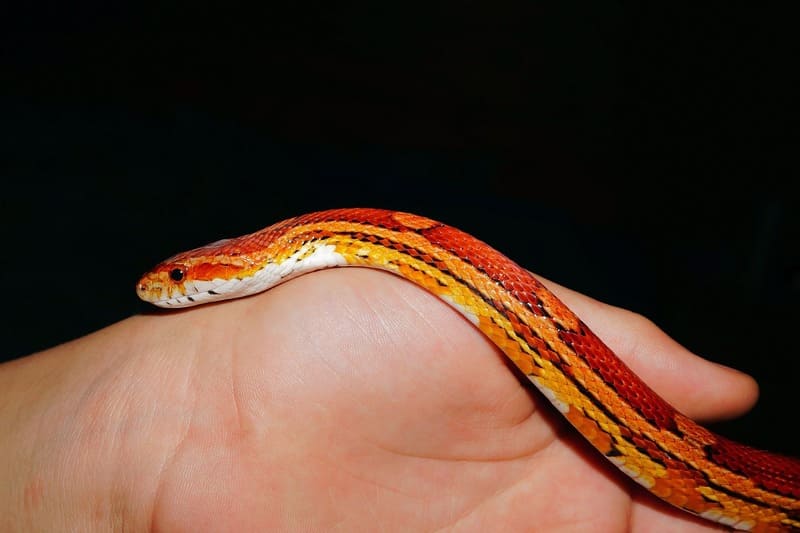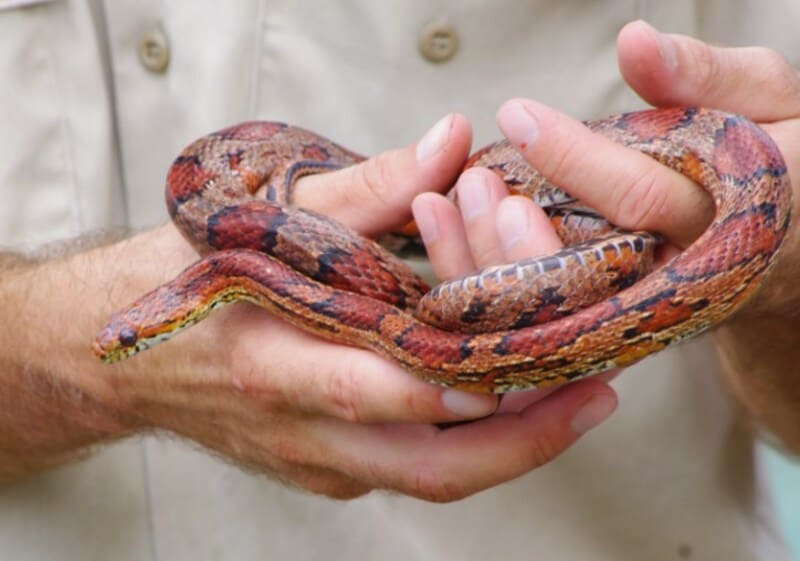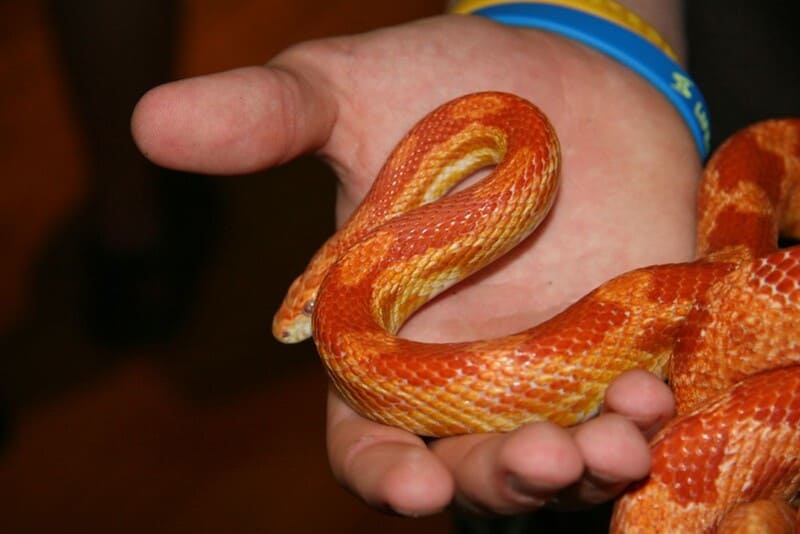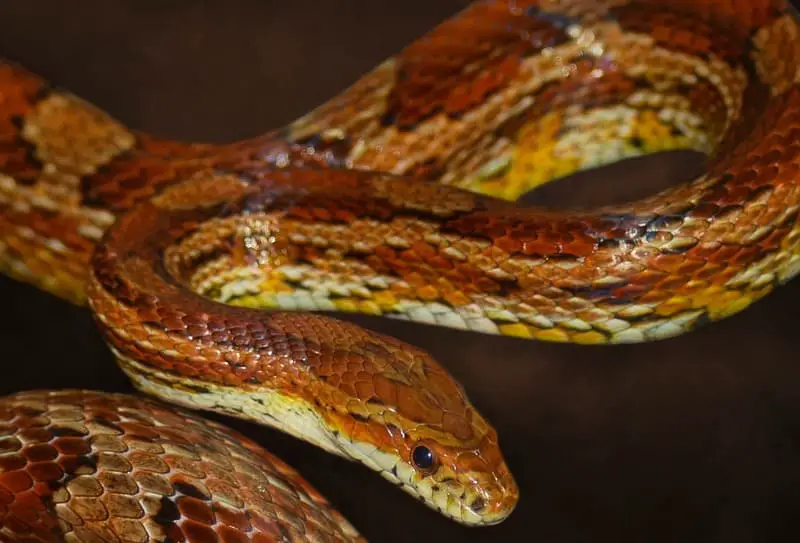Corn snakes, scientifically known as Pantherophis guttatus, are one of the most popular pet snakes in the United States. These non-venomous, relatively small constrictor snakes are known for their attractive patterns, manageable size, and docile nature. However, a common question among prospective and current corn snake owners is whether these reptiles actually enjoy being held. In this extensive article, we will explore the behavior and preferences of corn snakes, their interactions with humans, and tips for handling them safely and responsibly.

Understanding Corn Snakes
Before delving into the question of whether corn snakes like to be held, it’s essential to understand the basic nature and characteristics of these reptiles.
Natural Habitat
Corn snakes are native to the southeastern United States, where they inhabit a variety of environments, including forests, grasslands, and even agricultural areas. In the wild, they are often found in cornfields and other crop fields, which is how they got their common name.
Physical Characteristics
Corn snakes typically grow to a length of 3 to 5 feet, making them relatively small in comparison to some other snake species. They have slender bodies with a vibrant coloration and distinctive patterns. These patterns vary significantly among individual snakes but often include a series of reddish-brown blotches separated by smaller black or gray markings.
Lifespan
In captivity, well-cared-for corn snakes can live for 15 to 20 years, or even longer. Providing them with a suitable habitat and proper nutrition is essential for ensuring their longevity and well-being.
Temperament
Corn snakes are generally known for their docile and friendly nature. They are not prone to aggression and are usually quite tolerant of handling when raised in captivity. Their placid demeanor makes them a popular choice for beginner snake owners.
Do Corn Snakes Like to Be Held?
Now, let’s address the central question of whether corn snakes like to be held. The answer to this question may vary from one snake to another and depend on several factors.
Individual Variability
Just like humans, corn snakes have distinct personalities. Some may be more sociable and enjoy human interaction, while others may prefer a more solitary existence. A snake’s temperament can be influenced by factors such as genetics, early socialization, and its overall health and well-being.
Early Socialization
Corn snakes that are raised in captivity and regularly handled from a young age tend to be more comfortable with human interaction. These snakes are accustomed to the presence and touch of humans, which can make them more amenable to being held.
Body Language
To determine if a corn snake enjoys being held, it’s essential to observe its body language. Signs that a corn snake is comfortable with handling include:
1. Relaxed Body Posture:
When a snake is at ease, it will have a relaxed body with minimal tension. It will not exhibit signs of stress, such as coiling tightly, hissing, or striking.
2. Tolerance to Handling:
A snake that likes being held will tolerate gentle and respectful handling. It may explore your hands or arms with its tongue, flicking it in and out to sense its environment.
3. Active Exploration:
Some corn snakes may even display curiosity and actively explore their surroundings when being held. This behavior suggests that they are comfortable and engaged.
Signs of Discomfort
Conversely, if a corn snake is uncomfortable with being held, it may exhibit signs of stress, which can include:
1. Defensive Posture:
A stressed corn snake may coil tightly, flatten its body, or strike defensively. These behaviors indicate that it feels threatened and would prefer to be left alone.
2. Hissing or Vibrating Tail:
Some corn snakes may emit hissing sounds or vibrate their tail when stressed. This is a clear signal that they are unhappy with the current situation.
3. Attempted Escape:
If a snake repeatedly tries to escape when being held, it may not enjoy the experience. Constant efforts to get away from human contact suggest that the snake is not comfortable.
Habituation and Trust
Corn snakes can become more accustomed to handling over time. With consistent, gentle interaction and positive experiences, many corn snakes can build trust and become more comfortable with being held. This is especially true for snakes that may have had negative experiences or minimal handling in their early lives.

Benefits of Handling Corn Snakes
While individual snakes may have varying preferences for being held, there are several benefits to regular, gentle handling of corn snakes, which can positively impact their overall well-being.
Socialization
Handling a corn snake from a young age can help it become more accustomed to human interaction. This is particularly important for snakes that will be kept as pets, as it can lead to a more enjoyable ownership experience for the snake keeper.
Reducing Stress
Regular handling can help desensitize corn snakes to the presence of humans, reducing their stress levels when interacting with their owners. When handled correctly, snakes can become less prone to defensive behaviors like striking or hissing.
Health Monitoring
Handling your snake provides an opportunity to examine its overall health. You can check for any changes in its body condition, look for signs of injury or illness, and ensure that it is shedding properly. These regular health checks are essential for maintaining your snake’s well-being.
Enrichment
Handling can also serve as a form of environmental enrichment for corn snakes. It offers them a chance to explore new surroundings and interact with different textures and temperatures, which can be mentally stimulating.
Bonding
Some snake keepers develop a bond with their corn snakes over time. While snakes may not form emotional attachments in the way that mammals do, regular handling can help build trust and create a unique, positive relationship between the owner and the snake.
Responsible Handling Guidelines
While there are potential benefits to handling corn snakes, it’s crucial to follow responsible guidelines to ensure the well-being of both the snake and the handler. Here are some tips for responsible handling:
1. Wash Your Hands
Always wash your hands before and after handling your snake. This helps prevent the transfer of bacteria and other contaminants that can be harmful to both you and the snake.
2. Handle Gently
Handle your corn snake gently and with care. Avoid squeezing or gripping the snake too tightly, as this can cause stress and discomfort. Support the snake’s body and avoid sudden movements.
3. Choose the Right Time
Handling is best done during the day when corn snakes are typically more active. Avoid waking them up from their sleep or disturbing them when they are in their hiding spots.
4. Start Slow
If your corn snake is not used to handling, start with short sessions and gradually increase the duration as the snake becomes more comfortable. Be patient and don’t force the snake to be handled if it appears stressed.
5. Avoid Handling After Feeding
Do not handle your snake immediately after it has eaten. Give it at least 48 hours to digest its meal to prevent regurgitation, which can be harmful to the snake.
6. Support the Head
When picking up a corn snake, make sure to support its head. Snakes can be sensitive about their heads and may become defensive if they feel threatened in that area.
7. Be Mindful of Shedding
Snakes often shed their skin, and this process can make them more sensitive. Avoid handling your corn snake during shedding, as it can be uncomfortable for the snake.
8. Supervise Children
If you have children in the household, supervise their interactions with the snake closely. Teach them how to handle the snake gently and responsibly to prevent any accidents.
9. Learn the Signs
Familiarize yourself with the body language and behavior of your snake. If it displays signs of stress or discomfort, it’s best to return it to its enclosure and try again later.
10. Use a Snake Hook (Optional)
If you are unsure about your snake’s temperament or if it is displaying defensive behavior, you can use a snake hook to gently support its body and encourage it to move without directly handling it.
11. Avoid Overhandling
While some snakes may enjoy being held, it’s essential to avoid overhandling, which can cause stress. Give your snake plenty of time to rest and be undisturbed in its enclosure.

Handling Young vs. Adult Corn Snakes
Handling requirements and preferences may differ between young and adult corn snakes.
Handling Young Corn Snakes
Young corn snakes tend to be more nervous and skittish than adults. They are also smaller and more fragile, so handling should be kept to a minimum during their early months. Frequent handling can cause stress and may hinder their development and growth.
When you do handle young corn snakes, be sure to do so gently and briefly. As they grow and become more accustomed to human interaction, you can gradually increase the frequency and duration of handling.
Handling Adult Corn Snakes
Adult corn snakes are generally more robust and better suited to regular handling. They may be more comfortable with being held and may even enjoy exploring their surroundings. Nevertheless, it’s still crucial to handle them with care and respect their boundaries.
How to Build Trust with Your Corn Snake
If you have a corn snake that is initially nervous or defensive, you can take steps to build trust and improve its comfort level with being held.
1. Gradual Introduction
Start by simply being near the snake’s enclosure without attempting to handle it. Let the snake become accustomed to your presence and scent. Over time, it will become less stressed by your proximity.
2. Frequent but Short Sessions
Initiate brief handling sessions and gradually increase their duration as the snake becomes more comfortable. Keep sessions positive and end them before the snake shows signs of stress or discomfort.
3. Consistency
Consistency is key to building trust. Handle the snake regularly but in a routine and predictable manner. This helps the snake become more familiar with the handling process.
4. Positive Reinforcement
Reward your corn snake with a small treat (usually a mouse or rat, depending on its size) after successful handling sessions. This positive association can encourage the snake to view handling as a positive experience.
5. Respect Boundaries
Always be mindful of the snake’s boundaries. If it shows signs of stress or discomfort, put it back in its enclosure and try again later. Avoid pushing the snake past its comfort zone.
6. Be Patient
Building trust takes time, so be patient and don’t rush the process. Every snake is unique, and some may require more time and effort than others to become comfortable with handling.

When Not to Handle Your Corn Snake
There are specific situations when it’s best to avoid handling your corn snake altogether.
1. During Shedding
As previously mentioned, shedding is a sensitive time for snakes. Their skin becomes dry and tight, and their vision is often impaired. Handling during this period can cause stress and discomfort. It’s best to leave them alone until shedding is complete.
2. After Feeding
After a meal, corn snakes need time to digest their food properly. Handling them immediately after eating can disrupt the digestive process and may lead to regurgitation, which can be harmful to the snake.
3. Illness or Injury
If your corn snake is unwell or has an injury, it’s crucial to avoid handling it until it has fully recovered. Handling can stress the snake and hinder its healing process.
4. After Major Changes
Avoid handling your snake for a few days after any significant changes in its environment, such as a move to a new enclosure or a change in temperature or humidity. This allows the snake to acclimate to its new surroundings.
5. When Unfamiliar with Handling
If you are not confident in your ability to handle a snake or if you have a snake with an unknown temperament, it’s best to seek guidance from an experienced reptile keeper or a professional. Mishandling can lead to injury for both the snake and the handler.
Bonding with Your Corn Snake
While it’s important to recognize that snakes do not form bonds in the same way humans do, some snake keepers develop a sense of connection with their pets. Here are some ways to enhance your bond with your corn snake:
1. Respect and Trust
Building trust and respecting the snake’s boundaries are essential for any positive interaction. Over time, your snake will become more comfortable with your presence and handling.
2. Regular Interaction
Consistent and gentle handling helps the snake become more familiar with you. Routine interactions can lead to a sense of trust and security.
3. Observational Bond
Observing your snake’s behavior and understanding its preferences can create a unique form of connection. You can learn to anticipate its needs and provide for its well-being more effectively.
4. Positive Experiences
Make each handling session a positive experience for your snake. Use gentle handling techniques, avoid stressing the snake, and offer occasional treats as rewards for cooperation.
5. Avoid Overhandling
While regular interaction is beneficial, avoid overhandling your snake. Give it time to rest and be undisturbed. A well-rested snake is more likely to be comfortable during handling.
6. Enrichment Activities
Provide your snake with environmental enrichment, such as different hiding spots, climbing opportunities, and sensory experiences. This can create a sense of security and engagement for the snake.
7. Learn About Your Snake
Get to know your snake’s habits, likes, and dislikes. Every corn snake is unique, and understanding its individual preferences can strengthen your bond.
8. Routine Care
Proper care, including maintaining a clean enclosure, providing the right temperature and humidity levels, and offering a well-balanced diet, is a fundamental way to show your snake that you care about its well-being.
Conclusion
Whether or not corn snakes like to be held can vary from one snake to another and is influenced by factors such as individual temperament, early socialization, and overall health. Some corn snakes are more comfortable with handling and may even enjoy the interaction, while others may prefer a more solitary existence.
Responsible handling is essential for ensuring the well-being of your snake and yourself. This includes practicing proper hygiene, respecting the snake’s boundaries, and being mindful of when and how you handle it.
Building trust and a positive relationship with your corn snake is a rewarding experience that can enhance your ownership journey. While snakes may not form emotional bonds as mammals do, they can become accustomed to human interaction and even display curiosity and engagement during handling sessions.
Ultimately, whether or not your corn snake enjoys being held, providing it with a safe and enriched environment, proper care, and respectful handling will contribute to a healthy and contented life for your pet snake.
